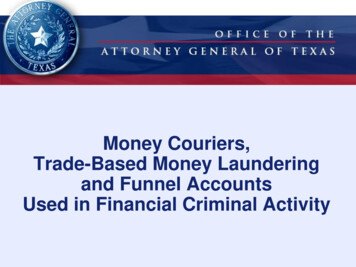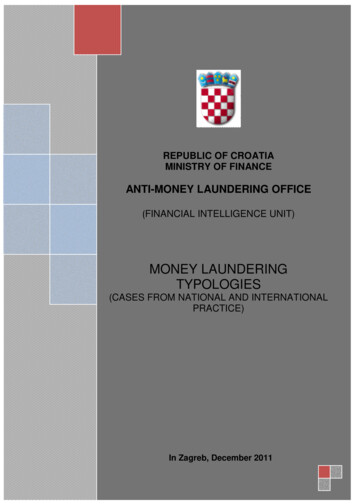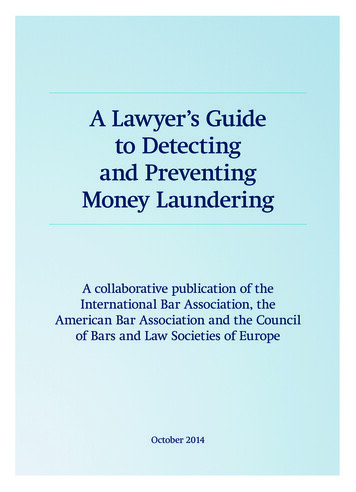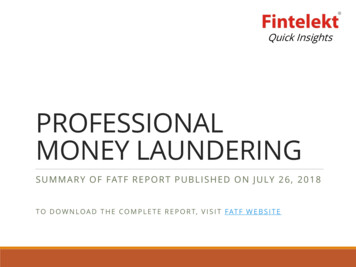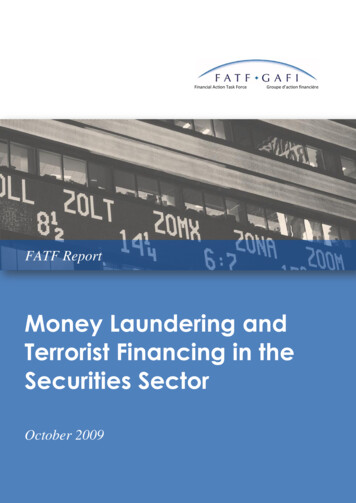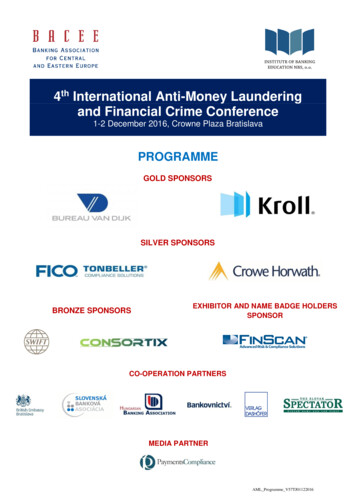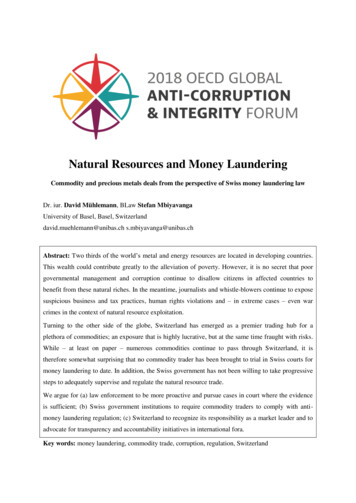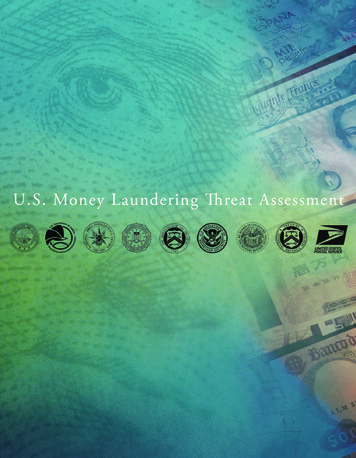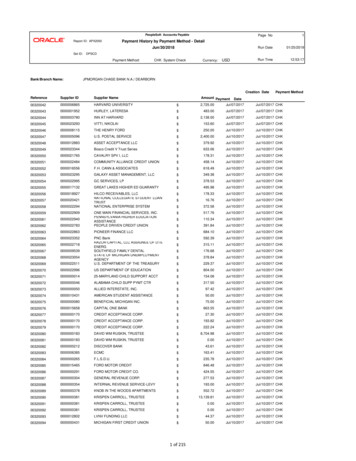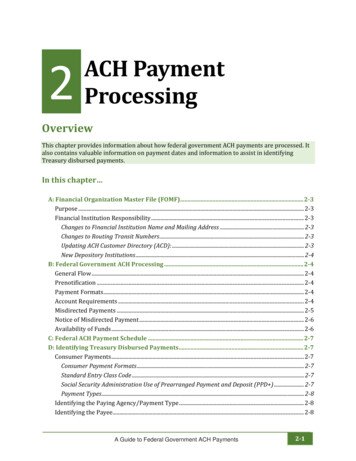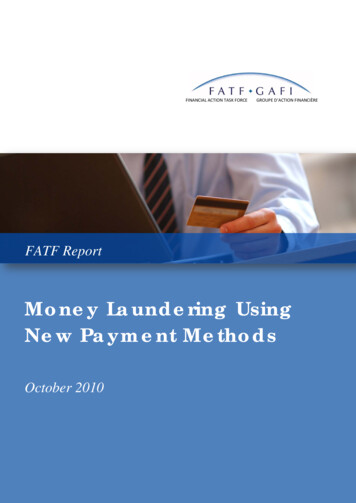
Transcription
FINANCIAL ACTION TASK FORCEGROUPE D’ACTION FINANCIÈREFATF ReportMoney Laundering UsingNew Payment MethodsOctober 2010
THE FINANCIAL ACTION TASK FORCE (FATF)The Financial Action Task Force (FATF) is an independent inter-governmental body that develops and promotespolicies to protect the global financial system against money laundering and terrorist financing.Recommendations issued by the FATF define criminal justice and regulatory measures that should beimplemented to counter this problem. These Recommendations also include international co-operation andpreventive measures to be taken by financial institutions and others such as casinos, real estate dealers,lawyers and accountants. The FATF Recommendations are recognised as the global anti-moneylaundering (AML) and counter-terrorist financing (CFT) standard.For more information about the FATF, please visit the website:WWW.FATF-GAFI.ORG 2010 FATF/OECD. All rights reserved.No reproduction or translation of this publication may be made without prior written permission.Applications for such permission, for all or part of this publication, should be made tothe FATF Secretariat, 2 rue André Pascal 75775 Paris Cedex 16, France(fax 33 1 44 30 61 37 or e-mail: contact@fatf-gafi.org).
Money Laundering Using New Payment Methods- October 2010 ACKNOWLEDGEMENTSThe FATF would like to thank Vodafone, Moneybookers and theConsultative Group to Assist the Poor (CGAP) for presentations providedto the project team during the 2009/2010 annual typologies experts’meeting in the Cayman Islands and MasterCard Europe for theirpresentation on prepaid cards at the project team’s intersessional meetingin Amsterdam in 2010. In addition, comments received from the GSMAand Western Union, during the FATF private sector consultation, were alsomuch appreciated. 2010 FATF/OECD - 3
Money Laundering Using New Payment Methods- October 20104 - 2010 FATF/OECD
Money Laundering Using New Payment Methods- October 2010 TABLE OF CONTENTSEXECUTIVE SUMMARY . 7 CHAPTER 1: INTRODUCTION . 9CHAPTER 2: BACKGROUND . 122.12.22.3Recent Developments Related to Prepaid cards . 14Recent Developments Related to Internet Payment Services . 16Recent Developments Related to Mobile Payment Services . 18 CHAPTER 3: RISK ASSESSMENT OF NPMS . 203.13.2Risk factors. 24Risk mitigants. 32 CHAPTER 4: TYPOLOGIES AND CASE STUDIES . 364.14.24.34.44.5Typology 1: Third party funding (including straw men and nominees) . 36Typology 2: Exploitation of the non-face-to-face nature of NPM accounts . 40Typology 3: Complicit NPM providers or their employees . 43Cross-border transport of prepaid cards . 46Red Flags. 47 CHAPTER 5: LEGAL ISSUES RELATED TO NPMS . 495.15.2.Regulatory models applied to NPMs . 49Specific issues in regulation and supervision of NPM . 53 CHAPTER 6: CONCLUSIONS AND ISSUES FOR FURTHER CONSIDERATION . 66APPENDIX A: SUPPLEMENTAL NPM QUESTIONNAIRE RESULTS AND ANALYSIS . 72APPENDIX B: EXCERPTS FROM THE 2006 REPORT ON NEW PAYMENT METHODS. 96APPENDIX C: RELATED PUBLICATIONS ON NPMS AND ML/TF RISK . 103APPENDIX D: THE EU LEGAL FRAMEWORK FOR NEW PAYMENT METHODS . 107APPENDIX E: GLOSSARY OF TERMS . 111 2010 FATF/OECD - 5
Money Laundering Using New Payment Methods- October 20106 - 2010 FATF/OECD
Money Laundering Using New Payment Methods- October 2010 EXECUTIVE SUMMARY1.After the 2006 New Payment Method (NPM) report, the growing use of NPMs and anincreased awareness of associated money laundering and terrorist financing risks have resulted in thedetection of a number of money laundering cases over the last four years.2.The project team analysed 33 case studies, which mainly involved prepaid cards or internetpayment systems. Only three cases were submitted for mobile payment systems, but these involved onlysmall amounts. Three main typologies related to the misuse of NPMs for money laundering and terroristfinancing purposes were identified: Third party funding (including strawmen and nominees). Exploitation of the non-face-to-face nature of NPM accounts. Complicit NPM providers or their employees.3.While the analysis of the case studies confirms that to a certain degree NPM are vulnerable toabuse for money laundering and terrorist financing purposes, the dimension of the threat is difficult toassess. The amounts of money laundered varied considerably from case to case. While some cases onlyinvolved amounts of a few hundred or thousand US dollars, more than half of the cases feature muchlarger amounts (four cases involved over 1 million US dollars mark, with the biggest involving anamount of USD 5.3 million).4.The project team retained and updated the 2006 report s approach to assessing moneylaundering and terrorist financing risk associated with NPMs and assesses the risk of each product orservice individually rather than by NPM category.5.Anonymity, high negotiability and utility of funds as well as global access to cash throughATMs are some of the major factors that can add to the attractiveness of NPMs for money launderers.Anonymity can be reached either “directly” by making use of truly anonymous products (i.e., withoutany customer identification) or “indirectly” by abusing personalised products (i.e., circumvention ofverification measures by using fake or stolen identities, or using strawmen or nominees etc.).6.The money laundering (ML) and terrorist financing (TF) risks posed by NPMs can beeffectively mitigated by several countermeasures taken by NPM service providers. Obviously,anonymity as a risk factor could be mitigated by implementing robust identification and verificationprocedures. But even in the absence of such procedures, the risk posed by an anonymous product can beeffectively mitigated by other measures such as imposing value limits (i.e., limits on transactionamounts or frequency) or implementing strict monitoring systems. For this reason, all risk factors andrisk mitigants should be taken into account when assessing the overall risk of a given individual NPMproduct or service.7.Across jurisdictions, there is no uniform standard for the circumstances in which a product orservice can be considered to be of “low risk”. Many jurisdictions use thresholds for NPM transactions orcaps for NPM accounts in order to define “low-risk scenarios”; but the thresholds and caps vary 2010 FATF/OECD - 7
Money Laundering Using New Payment Methods- October 2010significantly from jurisdiction to jurisdiction. Likewise, different views may be taken on the relevance ofcertain risk factors or of the effectiveness of certain risk mitigants, due to respective legal and culturaldifferences in jurisdictions.8.Some jurisdictions allow firms to apply simplified CDD measures in cases of predefined lowrisk scenarios. Again, there is no uniform standard across jurisdictions on the definition of “simplifiedCDD measures”. Some jurisdictions even grant a full exemption from CDD measures in designated lowrisk scenarios.9.Not all NPM services are subject to regulation in all jurisdictions. While the issuance ofprepaid cards is regulated and supervised in all jurisdictions that submitted a response to the projectquestionnaire, the provision of Internet payment and mobile payment services is subject to regulationand supervision in most, but not all jurisdictions (FATF Recommendation 23; SpecialRecommendation VI).10.The project team also identified areas where the current FATF standards only insufficientlyaccount for issues associated with NPMs: Where NPM services are provided jointly with third parties (e.g., card programmanagers, digital currency providers, sellers, retailers, different forms of “agents”),these third parties are often outside the scope of AML/CFT legislation and therefore notsubject to AML/CFT regulation and supervision. The concept of agents and outsourcingis only marginally addressed in the FATF 40 Recommendations and 9 SpecialRecommendations (in Recommendation 9 and Special Recommendation VI). Moreclarification or guidance from FATF on this issue would be welcome, especially as afew jurisdictions are considering a new approach on the regulation and supervision ofagents. Many NPM providers distribute their products or services through the Internet, andestablish the business relationship on a non-face-to-face basis, which, according toFATF Recommendation 8, is associated with “specific risks”. The Recommendations donot specify whether “specific risks” equates to “high risk” in the sense of FATFRecommendation 5; if so, this would preclude many NPM providers from applyingsimplified CDD measures. While FATF experts have recently come to the conclusionthat non-face-to-face business does not automatically qualify as a high risk scenario inthe sense of Recommendation 5, it would be helpful if this could be confirmed andclarified within the standards.11.It would be desirable if other Working groups within FATF decided to pick up the discussionsdescribed above to provide more clarity on the interpretation of the FATF Recommendations involved.Such work would not only be relevant and helpful for the issues of money laundering and terroristfinancing, but also for the issue of financial inclusion.12.NPMs (as well as other financial innovations) have been identified as powerful tools to furtherfinancial inclusion. Many of the challenges mentioned above (e.g., discussion on simplified CDD incases of low risk, full exemption from CDD, or the regulation and supervision of agents) are of highrelevance for the entire discussion around financial inclusion, going beyond the issue of the vulnerabilityof NPMs to ML/TF purposes alone.8 - 2010 FATF/OECD
Money Laundering Using New Payment Methods- October 2010 CHAPTER 1: INTRODUCTIONThe 2006 report13.In October 2006, the FATF published its first report on New Payment Methods (NPMs). Thereport was an initial look at the potential money laundering (ML) and terrorist financing (TF)implications of payment innovations that gave customers the opportunity to carry out payments directlythrough technical devices such as personal computers, mobile phones or data storage cards. 1 In manycases these payments could be carried out without the customer needing an individual bank account.14.As these NPMs were a relatively new phenomenon at the time, only a few ML/TF case studieswere available for the 2006 report. In addition, clear definitions of various NPM products and how theyshould be regulated were just beginning to be addressed by a limited number of jurisdictions. Thereforethe report focused on raising awareness of these new products and the potential for their misuse forML/TF purposes.15.The 2006 report found that ML/TF risk was different for each NPM product and that assessingthe ML/TF risk of NPM categories was therefore unhelpful. Instead, it developed a methodology toassess the risk associated with individual products.16.The report concluded that it should be updated within a few years, or once there was greaterclarity over the risks associated with these new payment tools. This report updates the 2006 report onNPMs and provides an overview of the most recent developments.Objectives of the present report17.Since the publication of the 2006 report, NPMs (prepaid cards, mobile payments and Internetpayment services) have become more widely used and accepted as alternative methods to initiatepayment transactions. Some have even begun to emerge as a viable alternative to the traditional financialsystem in a number of countries.18.The rise in the number of transactions and the volume of funds moved through NPMs since2006 has been accompanied by an increase in the number of detected cases where such payment systemswere misused for ML/TF purposes. The NPM report in 2006 identified potential legitimate andillegitimate uses for the various NPMs but there was little evidence to support this. The current reportwill compare and contrast the “potential risks” described in the 2006 report to the “actual risks” basedon new case studies and typologies. Not all potential risks identified in 2006 were backed up by casestudies. This does not mean that those risks are no longer of concern, and jurisdictions should continueto be alert to the market s development to prevent misuse and detect cases that went unnoticed before.19.The report will also develop red flag indicators which might help a) NPM service providers todetect ML/TF activities in their own businesses and b) other financial institutions to detect ML/TF1Including different storage media such as magnetic stripe cards or smart card electronic chips. 2010 FATF/OECD - 9
Money Laundering Using New Payment Methods- October 2010activities in their business with NPM service providers, in order to increase the number and quality ofsuspicious transaction reports (STRs).20.Although more case studies are now available, issues surrounding appropriate legislation andregulations for NPMs are still a challenge for many jurisdictions. Consequently, the report also identifiesthe unique legal and regulatory challenges associated with NPMs and describes the different approachesnational legislators and regulators have taken to address these. A comparison of regulatory approachescan help inform other jurisdictions’ decisions regarding the regulation of NPM.21.Finally, this report considers the extent to which the FATF 40 9 Recommendations continueto adequately address the ML/TF issues associated with NPMs.Steps taken by the project team22.The project team analysed publications about NPMs and ML/TF2. It also analysed theresponses to questionnaires which covered the spread of domestic NPM service providers 3, the role ofregulation in relation to NPMs and case studies detected in jurisdictions (the latter also including foreignservice providers). Thirty-seven jurisdictions and the European Union Commission submitted aresponse. 423.The majority of the respondents identified NPMs within their jurisdiction. Prepaid cards werethe most common (34 of the countries have such providers), followed by Internet payment services (IPS)providers with 17 countries and mobile payment services with 16 countries offering each NPMrespectively. Case studies were provided for the three NPMs: 18 cases involving prepaid cards, 14 casesinvolving Internet payment services and three cases involving mobile payment services. 5 A detailedsummary is attached in Appendix A.24.The project team also consulted with the private sector in several ways. During the 2009-2010annual typologies experts meeting in the Cayman Islands, representatives from NPM service providers,including the Internet payment sector, the mobile payments sector and a representative from theConsultative Group to Assist the Poor (CGAP), provided presentations to the project team. At theproject team s intersessional meeting in Amsterdam in March 2010, a representative from a cardtechnology provider in Europe gave a presentation on prepaid cards. A more wide-ranging private sector2See Appendix C for a list of publications used for this report.3Including a description of the biggest or most significant products and service providers.4The FATF and the NPM project team would like to thank all jurisdictions and organisations that havecontributed to the completion of this report by providing experts to participate in the project team and bysubmitting responses to the project questionnaire, including (sorted alphabetically): Argentina, Armenia,Australia, Austria, Belarus, Belgium, Brazil, Bulgaria, Canada, Cayman Islands, Colombia, Denmark,Estonia, European Commission, France, Germany, Gibraltar, Italy, Japan, Jersey, Lebanon, Luxembourg,Macao, Mexico, Netherlands, Norway, Oman, Peru, Philippines, Poland, Portugal, Russia, Singapore,Slovak Republic, South Africa, St. Vincent & the Grenadines, Sweden, Switzerland, UK, Ukraine, USA,and the World Bank. The project team would also like to thank the secretariat of the Egmont Group forcirculating the questionnaire among its members, thus increasing the outreach of the entire project.5Various reasons have been proposed for the low number of cases, including that transaction value andvolume remains very small for mobile payments, or that these systems may not be attractive to moneylaunderers, or that mobile providers and law enforcement have failed to detect criminality or that criminals,or indeed law enforcement are unfamiliar with the technology.10 - 2010 FATF/OECD
Money Laundering Using New Payment Methods- October 2010 consultation was also conducted through the FATF electronic consultation platform where a draft of thisreport was presented for consultation.Structure of the present report25.This report is based on the FATF 2006 report. It attempts to avoid repetition as much aspossible. The report therefore does not describe the general working mechanisms of NPMs. 6 Instead, itfocuses on recent developments, updates the risk assessment and introduces new case studies.26.6The report is divided into 4 sections: Section 1 (chapters 1 and 2) introduces the project work as well as the key overarching issues.It also provides an overview of recent developments; Section 2 (chapters 3 and 4) addresses the risks and vulnerabilities of NPMs and presents casestudies and typologies. Section 3 (chapter 5) addresses regulatory and supervisory issues, exploring the differentnational approaches to AML legislation as well as the prosecution of illicit NPM serviceproviders. Section 4 (chapter 6) concludes the report and identifies issues for further consideration.Relevant sections of the 2006 report (including definitions) are cited as excerpts in Appendix B. 2010 FATF/OECD - 11
Money Laundering Using New Payment Methods- October 2010CHAPTER 2: BACKGROUND“New Payment Methods” and their development since 200627.In 2006, bank-issued payment cards and transactions via the internet or over the telephonewere not really new. Depository financial institutions have offered remote access to customer accountsfor decades. What was new about these technologies in 2006 was their use by banks outside oftraditional individual deposit accounts and by non-banks, some of which did not fit traditional financialservice provider categories and therefore sometimes fell outside the scope of regu
payment services) have become more widely used and accepted as alternative methods to initiate payment transactions. Some have even begun to emerge as a viable alternative to the traditional financial system in a number of countries. 18. The rise in the number of tran
